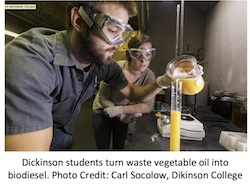 Green Plains Inc. has announced that its Board of Directors has approved a share repurchase program of up to $100 million of the Company’s shares of common stock effective immediately. Under the share repurchase program, Green Plains may repurchase shares from time to time in open market transactions, privately negotiated transactions, accelerated share buyback programs, tender offers or by other means. The timing and amount of repurchase transactions will be determined by the Company’s management based on its evaluation of market conditions, share price, legal requirements and other factors.
Green Plains Inc. has announced that its Board of Directors has approved a share repurchase program of up to $100 million of the Company’s shares of common stock effective immediately. Under the share repurchase program, Green Plains may repurchase shares from time to time in open market transactions, privately negotiated transactions, accelerated share buyback programs, tender offers or by other means. The timing and amount of repurchase transactions will be determined by the Company’s management based on its evaluation of market conditions, share price, legal requirements and other factors.- Ground was officially broken on the Red Rock Hydroelectric Project (RHHP), which will retrofit the Lake Red Rock Dam near Pella, Iowa to provide up to 55MW of power during peak seasons. RRHP is being built by Missouri River Energy Services, and Voith will supply the turbines, generators, and associated controls that will help provide power for an estimated 18,000 homes and businesses. The project has a target completion date of 2018.
- Ygrene Energy Fund, a leading national provider of residential and commercial property assessed clean energy (PACE) financing, has announced they have raised $30 million in growth capital from Virgo Investment Group. Ygrene will use the funds to grow its channel contractor network, further expand its national footprint, and accelerate market awareness for PACE financing. The company appointed Mike Cary, former President of CIT Home Lending, as COO to immediately execute on its growth initiatives.
- Juhl Energy, Inc. has announced they have completed its previously announced acquisition of two operating wind farms in Iowa. The $4 million acquisition closed on August 11th, 2014, and the wind projects are now wholly-owned by Juhl Energy. The two GE XLE 1.62 MW wind turbines are located in North Central Iowa near the towns of Manley and Kensett. The wind turbines are installed on private farmland approximately 10 miles apart from each other and have been commercially operating since 2011.

Quad County to Host Grand Opening
It’s the month of celebration for cellulosic ethanol in Iowa. On Tuesday, September 9, 2014 at 11:00 am Quad County Corn Processors will be hosting a grand opening event for its new “bolt on” biorefinery that produces cellulosic ethanol from corn kernel fiber. Quad County is the site of Iowa’s first cellulosic ethanol gallons and the world’s first corn kernel fiber cellulosic ethanol, a process that was invented by Plant Engineer Travis Brotherson and patented by Quad County Corn Processors.
 “After four years of research and development, financing hurdles, waiting on EPA rule clarifications and construction, we are excited to see the ACE project working and are proud to be producing the world’s first corn kernel fiber cellulosic ethanol gallons and Iowa’s first cellulosic ethanol gallons,” said Delayne Johnson, CEO of Quad County Corn Processors. “This state-of-the-art technology will create 2 million gallons of cellulosic ethanol out of the corn kernel cellulose, a feed stock that we already have on site.”
“After four years of research and development, financing hurdles, waiting on EPA rule clarifications and construction, we are excited to see the ACE project working and are proud to be producing the world’s first corn kernel fiber cellulosic ethanol gallons and Iowa’s first cellulosic ethanol gallons,” said Delayne Johnson, CEO of Quad County Corn Processors. “This state-of-the-art technology will create 2 million gallons of cellulosic ethanol out of the corn kernel cellulose, a feed stock that we already have on site.”
“In addition to creating 4 new full-time jobs in Galva, this process will increase our ethanol yields by six percent, increase our corn oil removal by three times and create a feed product that is much higher in protein and lower in fiber,” add Johnson. “In essence, we will create more value out of the corn bushels we already process which increases our efficiency so we can continue to be a leader in the ethanol industry.”
Confirmed speakers for the ceremony include: Bill Northey, Iowa Secretary of Agriculture; Bob Dinneen, President and CEO of the Renewable Fuels Association in Washington, DC; Monte Shaw, Executive Director of the Iowa Renewable Fuels Association; Brian Jennings, Executive Vice-President of the American Coalition for Ethanol; and David Witherspoon, Head of Renewable Fuels for Syngenta.
The public and media are invited. Event attendees can meet by the tents on the west side of the plant which is located at 6059 159th Street. Quad County is situated two miles south of Galva at the intersection of Highways 20 and M-25. Due to limited parking and truck traffic safety, guests are asked to park in the field northwest of the plant and enter the parking area from Highway M-25.
Ecotech’s Clean Jobs Index Shows Clean Job Growth
 There are more than two million job postings in the clean and sustainable energy sector for the first two quarters of 2014, according to Ecotech Institute’s Clean Job Index that looks at job postings in the green energy sector. This is nearly a 88 percent increase from this time last year. Ecotech Institute created the Clean Jobs Index to provide objective job information about the renewable energy industry.
There are more than two million job postings in the clean and sustainable energy sector for the first two quarters of 2014, according to Ecotech Institute’s Clean Job Index that looks at job postings in the green energy sector. This is nearly a 88 percent increase from this time last year. Ecotech Institute created the Clean Jobs Index to provide objective job information about the renewable energy industry.
Highlights from the Clean Jobs Index Q1 and Q2 2014:
- Number of U.S. Clean Jobs Postings in Q1 and Q2 2014: 2,637,133 (an 87.5 percent increase from Q1 and Q2 2013)
- Number of New Clean Jobs since January 1, 2014: 1.2 million
Ecotech Institute prepares students for jobs in clean energy. Below is a list of some of the fastest growing job sectors of clean energy:
- Power Utility Technology: 132 percent increase in jobs from 2013
- Solar Energy Technology: 116 percent increase in jobs from 2013
- Electrical Engineering Technology: 74 percent increase in jobs from 2013
- Wind Energy Technology: 65 percent increase in jobs from 2013
- Facility Management: 64 percent increase in jobs from 2013
- Renewable Energy Technology: 63 percent increase in jobs from 2013
- Energy Efficiency: 53 percent increase in jobs from 2013
“This Clean Jobs Index really demonstrates the rapid growth of the sustainable energy industry,” said Chris Gorrie, academic dean at Ecotech Institute. “Almost double the clean jobs were posted in the first half of 2014 compared to the first half of 2013. Ecotech Institute is the only educational institution out there that’s entirely focused on this space, and makes sure students are prepared for these available green energy jobs.”
Propane Expands Use on the Farm
![]() Farmers across the country are turning more and more to propane for their operations. A new study sponsored by the Propane Education & Research Council (PERC) shows that farmers looking to cut fuel costs, increase efficiencies, and meet strict emissions standards are turning to the clean-burning fuel.
Farmers across the country are turning more and more to propane for their operations. A new study sponsored by the Propane Education & Research Council (PERC) shows that farmers looking to cut fuel costs, increase efficiencies, and meet strict emissions standards are turning to the clean-burning fuel.
Propane is currently used by more than 40 percent of farms in the U.S. According to a survey conducted by PERC and Artemis Strategy Group, the most common uses for propane among farmers are building heating (47 percent) and grain drying (35 percent).
The survey also showed that the role of propane on farms is changing, as more farmers are choosing propane to fuel vehicles and irrigation systems over other alternative fuels such as natural gas. According to the survey, 14 percent are using propane to fuel a vehicle on the farm (compared with natural gas at one percent) and five percent are using propane for irrigation (compared with natural gas at two percent).
“The results show that farmers trust propane as a reliable, convenient, American-made fuel,” Cinch Munson, PERC director of agriculture business development, said. “Every year, new, fuel-efficient propane-powered irrigation engines, grain dryers, work trucks, and forklifts are hitting the market. As more options become available, more farmers will turn to propane for greater efficiency and fuel savings.”
The survey also shows that farmers like using propane, as favorability ratings hit about 84 percent for propane, compared with 61 percent for natural gas and 33 percent for heating oil. PERC also touted its partnerships with equipment manufacturers with research and development investments to commercialize new propane-powered products or advance the energy efficiency of existing applications.
Bacon-Biodiesel Bike Makes Cross-Country Trip
 Bikes, biodiesel and bacon… what more could a guy (or gal) want? In what could be the tastiest source ever for biodiesel, a motorcycle fueled by bacon grease biodiesel has driven to the West Coast. This article from the Austin (MN) Daily Herald says hometown Hormel Foods Corp. is sponsoring a motorcycle that runs on biodiesel made of bacon grease for the Aug. 29 International Bacon Film Festival in San Diego, Calif. and is being filmed along the way for a movie called “Driven By Bacon” to be shown at the film festival.
Bikes, biodiesel and bacon… what more could a guy (or gal) want? In what could be the tastiest source ever for biodiesel, a motorcycle fueled by bacon grease biodiesel has driven to the West Coast. This article from the Austin (MN) Daily Herald says hometown Hormel Foods Corp. is sponsoring a motorcycle that runs on biodiesel made of bacon grease for the Aug. 29 International Bacon Film Festival in San Diego, Calif. and is being filmed along the way for a movie called “Driven By Bacon” to be shown at the film festival.
Hormel representatives say the marketing push is an exciting opportunity to spread the word about Hormel’s Black Label Bacon brand and will likely be used as a promotional tool in the future.
“It was a really exciting idea,” said Nick Schweitzer, brand manager for meat production at Hormel.
Several people, including Charlie Smithson of CSE Engineering and Taylor Bamber, Smithson’s work partner, will also be on the trip to troubleshoot problems with the motorcycle.
Smithson and Bamber custom designed the motorcycle based on a 2011 Track T-800CDI model.
Officials say the motorcycle could end up in Hormel’s Spam Museum.
Project Liberty to Celebrate with Grand Opening
POET-DSM’s Project LIBERTY is celebrating the ethanol plant’s production of cellulosic ethanol produced from corn stover and corn cobs during a grand opening celebration on Wednesday, September 3, 2014. The event will be held in Emmetsburg, Iowa and will showcase what POET-DMS calls a “first-of-its-kind technology that is poised to dramatically expand the world’s resources for transportation fuel”.
 The Grand Opening will feature plant tours, a formal ceremony, a flyover by the ethanol-powered Vanguard Squadron, booths, music and more. The public is invited to attend and lunch will be provided.
The Grand Opening will feature plant tours, a formal ceremony, a flyover by the ethanol-powered Vanguard Squadron, booths, music and more. The public is invited to attend and lunch will be provided.
Project LIBERTY will process 770 tons of corn cobs, leaves, husk and some stalk daily to produce 20 million gallons of cellulosic ethanol per year, later ramping up to 25 million gallons per year. Plant personnel are currently running biomass through the pretreatment process and preparing for the first gallons of ethanol. Project LIBERTY will be the flagship plant in POET-DSM Advanced Biofuels’ plan to license this technology to companies across the U.S. and around the world.
Public tours will be available from 9:00 am to 11:00 am and 1:45 pm to 4:00 pm. A grand opening ceremony will take place from 11:00 am to 12:20 pm. Lunch will be provided and visitors can also view booths and equipment from 9:00 am to 5:00 pm. Location is 777 Main Street in Emmestburg, Iowa, 50536. There will be no public parking at the site. Free parking and regular shuttles will run from the Wild Rose Casino parking lot.
Virent Receives EPA Approval for BioForm
 The U.S. Environmental Protection Agency (EPA) has awarded Virent fuel registration for its BioForm Gasoline in blends of up to 45 percent. As a registered fuel, Virent’s biogasoline can now be used in on-highway motor vehicles. According to Virent, BioForm Gasoline is a high octane, direct replacement fuel made from plants that offers the benefits of high performance and blend rates, complete compatibility with existing refining and distribution infrastructure networks and reduced carbon footprint.
The U.S. Environmental Protection Agency (EPA) has awarded Virent fuel registration for its BioForm Gasoline in blends of up to 45 percent. As a registered fuel, Virent’s biogasoline can now be used in on-highway motor vehicles. According to Virent, BioForm Gasoline is a high octane, direct replacement fuel made from plants that offers the benefits of high performance and blend rates, complete compatibility with existing refining and distribution infrastructure networks and reduced carbon footprint.
“Securing EPA registration of our BioForm Gasoline is further confirmation of Virent’s high quality drop-in fuel and is another step towards commercializing our technology to produce renewable fuels and chemicals from biobased feedstocks,” said Lee Edwards, CEO and President of Virent. “We would also like to recognize our longtime collaborator Royal Dutch Shell for supporting the registration and testing process.”
The BioForm Gasoline blended with conventional gasoline underwent testing at Southwest Research Institute (SWRI) with the results demonstrating that the emissions from the blended fuel were well below the maximum permitted by current regulations, according to Virent. The BioForm Gasoline was manufactured by Virent at its demonstration plant in Madison, Wisconsin, which is capable of producing up to 10,000 gallons of biofuels and biochemicals per year. The EPA testing work was funded by Virent partner Royal Dutch Shell.
Matthew Tipper, Shell Vice President Alternative Energies, added, “Shell is pleased to see continued progress of biofuels as a road transport fuel in the United States as evidenced by this most recent EPA registration of a plant-based alternative fuel. This success demonstrates the progress being made by the biofuels industry. Also, it supports a continuation of a framework for expanding commercialization and use of biofuels, including advanced biofuels produced from non-food based plant alternatives, in the United States.”
Solar & Storage Microgrid Project Planned for Vermont
A new solar + storage microgrid project has been announced for Rutland, Vermont. The Stafford Hills project is being developed by Green Mountain Power in collaboration with Dynapower and GroSolar. The U.S. Department of Energy, Office of Electricity along with the Energy Storage Technology Advancement Partnership (ESTAP) funded the energy storage component project along with funds from the State of Vermont. In addition, the project is being managed by Clean Energy States Alliance and Sandia National Laboratories.
 “This project is a national model for the future of clean energy – combining solar with energy storage,” said Lewis Milford, president of Clean Energy Group, which manages the Clean Energy States Alliance. “Solar power and battery storage will provide clean reliable power to a school that serves as an emergency shelter, helping a community cope with loss of power in a future disaster. This new form of resilient power is what all communities need to protect themselves from power outages in severe weather events.”
“This project is a national model for the future of clean energy – combining solar with energy storage,” said Lewis Milford, president of Clean Energy Group, which manages the Clean Energy States Alliance. “Solar power and battery storage will provide clean reliable power to a school that serves as an emergency shelter, helping a community cope with loss of power in a future disaster. This new form of resilient power is what all communities need to protect themselves from power outages in severe weather events.”
According to Clean Energy Group, this project is unique in several ways:
- It is one of the first exclusively solar-powered microgrids in the US, and the first to provide full back-up to an emergency shelter on the distribution network;
- It is the first solar+storage microgrid to be developed on a brownfield site, contributing to brownfield redevelopment efforts in Rutland, VT;
- It incorporates 7,722 solar panels, capable of generating 2.5 MW of electricity, helping GMP to reach its goal of making Rutland, VT the Solar Capital of New England, and helping Vermont to reach its renewable energy goals;
- It incorporates 4 MW of battery storage, both lithium ion and lead acid, to integrate the solar generation into the local grid, and to provide resilient power in case of a grid outage;
- It incorporates innovative multi-port inverters designed specifically for this project by Dynapower, a local Vermont firm;
- It will provide resilient power to a Rutland school that serves as a public emergency shelter (additional critical facilities may be similarly supported by this microgrid in the future); and
- It will provide clean, distributed generation and resilient power to an economically challenged, urban community that is targeted for revitalization, and that suffers frequent power outages due to storms.
Dr. Imre Gyuk, Energy Storage Program Manager in the Office of Electricity Delivery and Energy Reliability, U.S. Department of Energy, added, “This project provides resilient power during emergencies while benefitting the grid at other times. The technical innovations will reduce cost and make the project commercially viable. This is the perfect project! It has social value, technical innovation, and furthers renewable integration for the grid.”
Sierra Magazine Releases 2014 Coolest Schools
The “Coolest Schools” in America rankings are out and the top school is University of California, Irvine. Compiled annually by Sierra Club, the rankings focus on America’s greenest colleges. The ranking universities displayed a deep and  thorough commitment to protecting the environment, addressing climate issues, and encouraging environmental responsibility. More than 150 schools filled out an extensive survey created in a collaboration between Sierra and the Association for Advancement of Sustainability in Higher Education. Using a customized scoring system, Sierra ranked the universities based on their commitment to upholding high environmental standards.
thorough commitment to protecting the environment, addressing climate issues, and encouraging environmental responsibility. More than 150 schools filled out an extensive survey created in a collaboration between Sierra and the Association for Advancement of Sustainability in Higher Education. Using a customized scoring system, Sierra ranked the universities based on their commitment to upholding high environmental standards.
“For eight years Sierra magazine has encouraged America’s colleges and universities to fully embrace their unique and multifaceted role in tackling the climate crisis and protecting America’s air, water, public health, and beautiful places,” said Bob Sipchen, Sierra magazine’s editor in chief. “From innovative research and development to powering campuses with wind and solar, to educating students in the most advanced thinking on sustainability, colleges and universities are leaders and models for the rest of society. Sierra magazine congratulates those that made our annual ‘Coolest Schools’ list.”
Sierra magazine’s top 10 schools of 2014 are:
1. University of California, Irvine (Irvine, CA)
2. American University (Washington, DC)
3. Dickinson College (Carlisle, PA)
4. Loyola University Chicago (Chicago, IL)
5. Lewis and Clark College (Portland, OR)
6. Stanford University (Stanford, CA)
7. University of South Florida (Tampa, FL)
8. Green Mountain College (Poultney, VT)
9. University of Connecticut (Storrs, CT)
10. Georgia Institute of Technology (Atlanta, GA)
This is UC Irvine’s fifth consecutive year as a top 10 finalist, but its first time as the winner, thanks in part to its three on-campus solar projects, a 19-megawatt turbine cogeneration plant, and energy-efficiency goals that are consistently exceeded. Other factors that helped those at the top of our list: American University has D.C.’s largest solar array; Dickinson runs an organic farm; Stanford is divesting from coal; and USF supplies a solar charging station for electric vehicles.
“The Cool Schools ranking is yet another indication of how deeply young people understand the benefits of clean energy and of how adept they are at turning awareness into action,” said Karissa Gerhke, director of the Sierra Student Coalition. “To capitalize on this power, the Sierra Student Coalition will join with students across the country this fall to launch the Campuses for Clean Energy campaign, a transformative movement that will demand 100 percent clean energy for campuses.
BioEnergy Bytes
 Wide bandgap (WBG) materials such as silicon carbide (SiC) and gallium nitride (GaN) are best positioned to address emerging power electronics performance needs in electric vehicles (EVs), with SiC displacing silicon as early as 2020, according to Lux Research report, “Silicon vs. WBG: Demystifying Prospects of GaN and SiC in the Electrified Vehicle Market“. As silicon struggles to meet higher performance standards, WBG materials are benefiting critically from evolving battery economics.
Wide bandgap (WBG) materials such as silicon carbide (SiC) and gallium nitride (GaN) are best positioned to address emerging power electronics performance needs in electric vehicles (EVs), with SiC displacing silicon as early as 2020, according to Lux Research report, “Silicon vs. WBG: Demystifying Prospects of GaN and SiC in the Electrified Vehicle Market“. As silicon struggles to meet higher performance standards, WBG materials are benefiting critically from evolving battery economics.- Hanergy Holding Group Limited, a multinational clean-energy power generator and a leading thin-film solar company, today announced that it has completed the acquisition of Alta Devices, whose thin film solar technology has a conversion efficiency of 30.8 percent, the highest among the solar energy technologies currently available in the world.
- Whether it’s established markets concerned about securing long-term energy supply or emerging nations seeking to efficiently improve their generating capacity, biomass for power generation is taking a strong hold on the global market. According to the July analysis of the Waste Business Finder database, published in Waste Industry Sales Monitor, there were 43 such projects, with an identifiable value of US $1.3 billion. The popularity of biomass is being driven by the array of biomass types – from animal/agricultural waste, through domestic food waste to forestry residues – allowing countries to specialize in the types most available to them. In this way, developing countries such as Burma, Honduras or Nigeria, which all reported developments in the month, can more easily meet their growing electricity generation needs.
- The U.S. carport market has emerged as a substantial component of the U.S. solar industry. According to the latest report from GTM Research, “U.S. Solar Carport Market 2014-2018: Landscape, Outlook and Leading Companies,” the U.S. is forecasted to add over 180 megawatts of solar carports in 2014, making it the fourth consecutive year with more than 100 megawatts installed.
